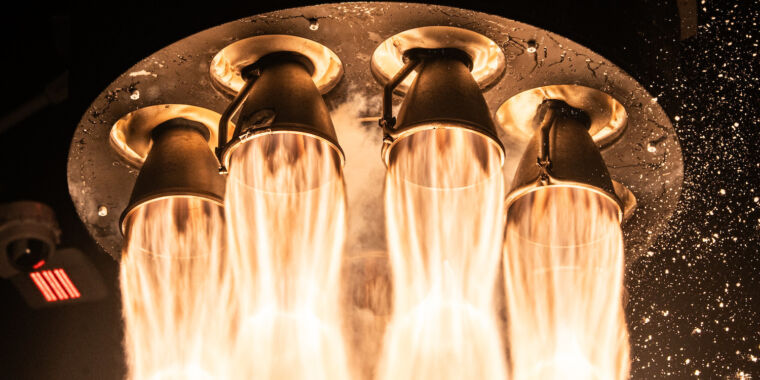[ad_1]
Not a lot of spacecraft have gone aloft with poetry etched on their sides. Actually, no spacecraft has ever gone aloft with poetry etched on its side—but no spacecraft has ever been quite like NASA’s Europa Clipper.
The ship, which is in its final stages of assembly, will launch in October, making a long, six-year journey out to Jupiter. Once there, it will execute a series of close-up flybys of the planet’s mysterious moon Europa—a world that has an icy shell and a globe-girdling ocean, and is the one place in the solar system outside of Earth that astronomers and exobiologists consider the likeliest to harbor life.
That kind of promise is the stuff of cosmic lyricism, and last year, U.S. Poet Laureate Ada Limón penned some verse in honor of both the moon and the mission, writing in part:
[E]ach rivulet, each pulse, each vein.
O second moon, we, too, are made of water,
Of vast and beckoning seas.
We, too, are made of wonders, of great.
And ordinary loves, of small invisible worlds,
Of a need to call out through the dark.
Come 2030, when the spacecraft arrives in the Jovian system, call out through the dark it will—perhaps answering the long-compelling question of whether we are all alone in a cold and vast universe or if somewhere out there we have company. “We’re trying to understand the potential habitability of Europa,” says NASA project scientist Robert Pappalardo. “Is it a place that has the ingredients for life, the conditions for life? What is its chemistry like? Its metabolism?”
Adds NASA program scientist Curt Niebur: “The more we learn about Europa the more it looks like those ingredients are likely going to be present.”
It was in 1610 that the legendary astronomer Galileo Galilei discovered the four large moons of Jupiter, which would come to be named Io, Europa, Ganymede, and Callisto. Today, they are known to be part of a litter of at least 95 moons orbiting the giant planet. It was 405 years later, in 2015, that the decidedly less well-known John Culberson, a former Texas congressman, whose district included parts of Houston—home of NASA’s Johnson Space Center—steered legislation through Congress providing funding for both a Europa orbiter and a lander later. He also made the projects a mandatory part of NASA’s exploration agenda. Europa missions, he told TIME shortly after the measure passed, are the only ones “it is illegal not to fly.”
Those flights could turn up a lot. As Io, Europa, Ganymede, and Callisto orbit Jupiter, they are held tight in the planet’s gravitational vise, but each satellite’s much weaker gravity has an influence on its sister moons too—plucking them as they pass one another and causing them to flex slightly, much like our own moon pulls and releases tides on Earth. For the Jovian moons, all that stretching and squeezing produces a lot of internal heat. On Io, the innermost of the four large moons, this leads to volcanoes, with up to 400 active eruptions taking place at any time. On Europa, this means that the moon’s icy shell does not remotely extend down to its solid crust. Instead, NASA estimates that the ice rind is no thicker than 15 to 25 km (10 to 15 mi.) while the ocean beneath it reaches a depth of an additional 60 to 150 km (40 to 100 mi.). At just 3,100 km (1,940 mi) in diameter, Europa is roughly a quarter the size of Earth, but its great single ocean is thought to contain twice as much water as all of our planet’s oceans combined.
What’s more, that water is not standing still. Forever sloshing around the moon, it causes fractures in the ice sheet as well as massive glacier-like spires that break free and then freeze jaggedly in place, and geysers that erupt high above the Europan surface. Water falling back to the moon as well as more that seeps up through the cracks in the ice produce rusty red stains on portions of the surface. That is a tantalizing chemical signature that Europa’s ocean might be much like Earth’s oceans.
“The water likely contains sodium chloride, or ordinary table salt,” says Pappalardo. “Radiation from charged particles trapped in Europa’s magnetosphere would turn it a reddish brown.”
Salt isn’t all that’s stirred into the Europan water. The ocean is in continuous contact with the silt at its bottom and likely picks up multiple organic chemicals, including nitrogen, phosphorus, and sulfur, as well as dissolved oxygen and hydrogen molecules. All of that makes for a rich, warm, amniotic environment in which life would have had plenty of opportunity to emerge. Making the case for biology stronger still is the possible presence of hydrothermal vents on Europa’s ocean floor. On Earth, these geologically heated geysers support all manner of life miles below the surface; Europa, with its flexing crust, could easily be home to similar processes.
“It’s not just unicellular life [around Earth’s hydrothermal vents],” says Niebur. “It’s multicellular, complex life forms that are down there living in complete darkness, driven by internal heat. Well, Europa has an internal heat source as well.”
Of course, scientists are not remotely ready to say that just because biology could be present on Europa that it is present. Europan life would need not just the right chemical ingredients, not just the presence of water, not just a sufficient source of energy, such as the moon’s tidal heating. It would also need a lot of time.
“You need stability,” says Niebur. “It doesn’t help if you put those ingredients together for 20 minutes; life isn’t going to begin and evolve in that kind of timespan. You need an environment that’s going to be stable for millions of years.”
There’s one other indispensable thing too—something no evolutionary biologist or exobiologist has ever defined. “We have to know what’s necessary to go from chemicals to chemical energy to life,” says Pappalardo. “We don’t understand what that extra spark is.”
Patience will be required before those and other answers are forthcoming. The Europa Clipper is scheduled to launch this fall atop a SpaceX Falcon Heavy rocket, the most powerful rocket in the company’s fleet, producing 2.3 million kg (5 million lbs) of thrust at take-off. Ordinarily, the Falcon Heavy conserves some of its fuel on the way up, allowing its engines to continue burning so its three stages can descend gently to Earth where they can be recovered, refurbished, and reused. That will not be the case for this launch. NASA intends to squeeze every ounce of energy—and every drop of fuel—from the Falcon, giving Europa Clipper the greatest thrust possible and leaving the three spent stages to crash back into the ocean.
“We’re going to burn the boosters and not recover them in order to get the maximum throw from the rocket,” says Pappalardo.
That will indeed give the spacecraft a lot of kick, sending it off at a blazing 40,200 km/h (25,000 mph) relative to the in-motion Earth, and up to 129,000 km/h (80,000 mph) relative to the stationary sun. Even that, however, means that Europa Clipper will not arrive in the Jovian system until April 2030. It will spend close to one more year orbiting Jupiter and using the gravity of the three other large moons to shape its trajectory, pointing it toward Europa. In 2031 it will at last begin its science campaign, making nearly 50 passes by Europa—some as close as 25 km (16 mi.)—across the span of three years, with the possibility of a mission extension if the hardware and the money allow.
“It depends on how the spacecraft is doing and NASA’s funding situation,” says Pappalardo. “We’d have to determine the goals for an extended mission, but I imagine we will find some areas that are especially interesting that we want to go after more intensively.”
The betting is that the ship will indeed be able to stay in service beyond its minimum of three years. NASA historically lowballs its mission timelines in order to keep expectations in check and make it easy for its spacecraft to exceed them. Before the Spirit and Opportunity rovers landed on Mars in 2004, the space agency announced that they would function for a minimum of 90 days, with any time beyond that considered a bonus. Ultimately, Spirit remained at work for six years and Opportunity for 15. Europa Clipper is built for similar longevity.
The main body of the spacecraft is 5 m (16 ft.) tall, but when its power-generating solar panels are extended, it stretches 30 m (100 ft.)—about the length of a basketball court—to maximize the energy it collects from the distant sun. It’s equipped with 24 engines, which will allow it to slalom through the obstacle course of Jupiter’s many moons, taking precise aim at Europa. The spacecraft is also equipped with nine different science instruments, including wide- and narrow-field cameras, a temperature-measuring system, a mass spectrometer to study the chemistry of both the surface of Europa and its exceedingly tenuous atmosphere, a gravity sensor that will determine how much the moon is flexed and squeezed as it moves through its orbits, a magnetometer to measure the thickness of the ice shell and another one that can help determine the depth and salinity of Europa’s ocean.
No matter what Europa Clipper does or doesn’t discover, Culberson’s 2015 law means that unless Congress repeals the Europa provision, a landing mission will come next—but that doesn’t mean it will come soon. The space agency conducts what it calls decadal surveys to select missions for the upcoming ten years and the next review is not due until 2030—or right about the time Europa Clipper is arriving at Jupiter. Planning, designing, and building a lander could easily take another decade still.
“Unfortunately,” Pappalardo says, “[the mission] might be in the 2040s.”
Europa, of course, is patient. Birthed 4.5 billion years ago, at the dawn of the solar system, it has billions more years left to it—years in which any life it may harbor today can continue to grow, flourish, and beckon humans outward. “We are creatures of constant awe,” wrote Limón in another line of her poem. If there is life on Europa, that very human quality should inspire more Jovian journeys.
Maqvi News #Maqvi #Maqvinews #Maqvi_news #Maqvi#News #info@maqvi.com
[ad_2]
Source link

















































